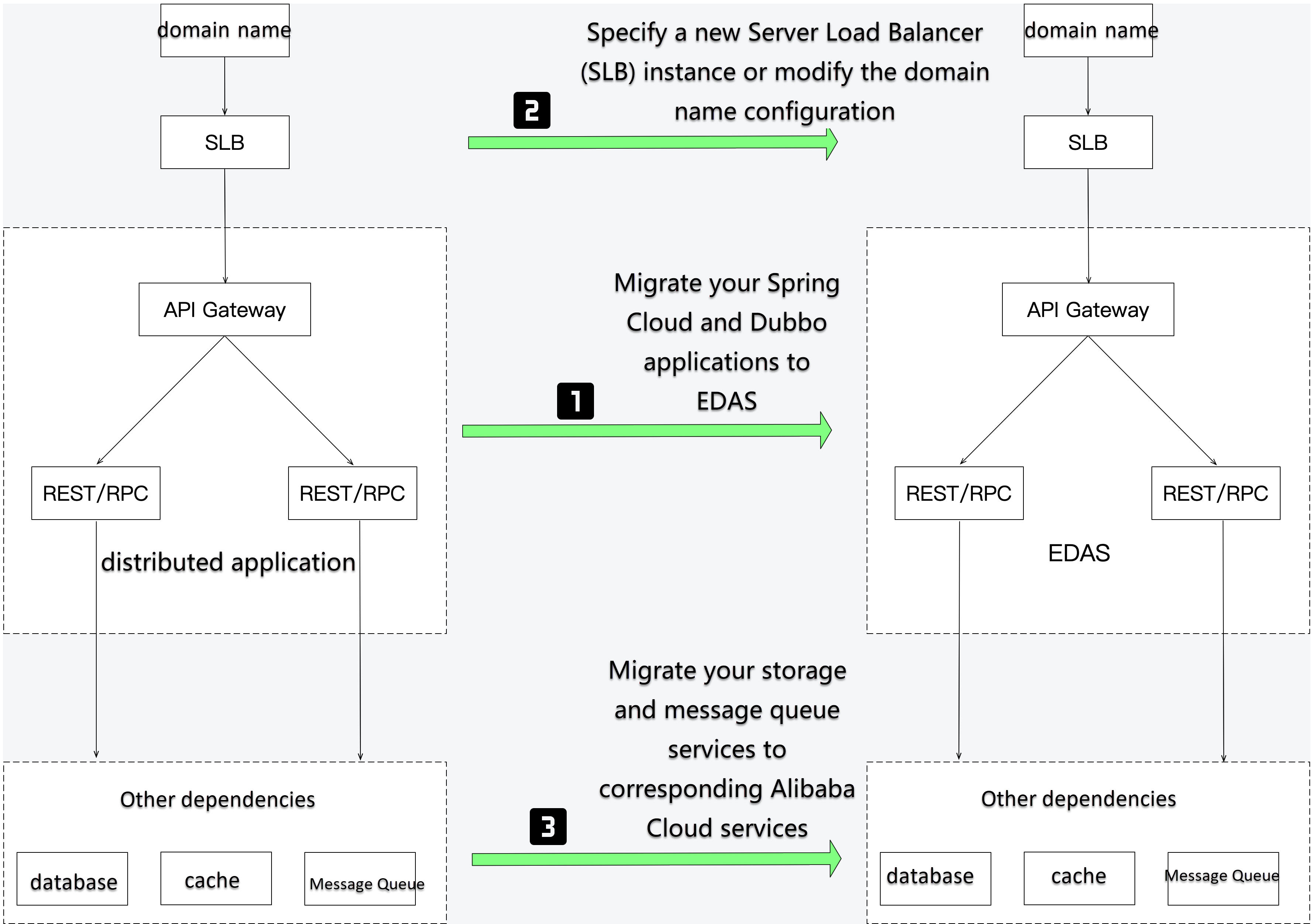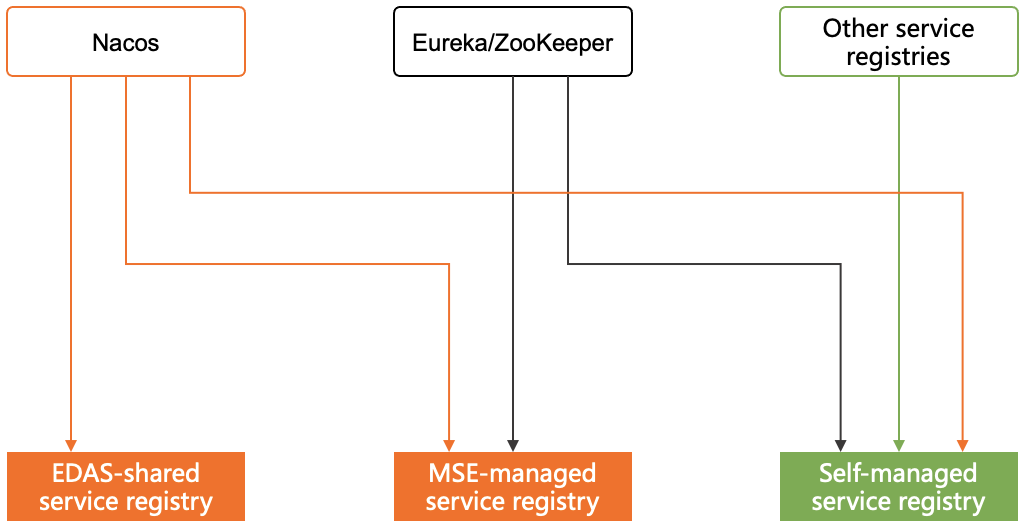Enterprise Distributed Application Service (EDAS) allows you to migrate Spring Cloud applications of Edgware or later versions and Dubbo applications of version 2.5.3 or later to EDAS. You can migrate your Spring Cloud and Dubbo applications to EDAS without modifying the application code. After the migration, you can manage the lifecycle of the applications in EDAS. You can use microservice governance features such as integrated monitoring, management, and control, trace queries, and throttling and degradation for the applications. In addition, EDAS provides differentiating capabilities for microservice governance, such as canary release, outlier ejection, graceful shutdown, and service authentication.
Architecture of seamless migration

- Required. Migrate your Spring Cloud and Dubbo applications to EDAS.
- If you want to retain your existing self-managed registry after the migration, you need to only migrate the applications to EDAS. You do not need to migrate the configurations of the registry.
- If you do not want to use the self-managed registry after the applications are migrated, you can use one of the following methods to migrate the configurations of the registry to EDAS. For more information about how to select a registry, see the Registry selection section of this topic.
- Dual registration and dual subscription
- Registry switching
- Optional: Specify a new Server Load Balancer (SLB) instance or modify the domain name configuration. After the applications are migrated, you need to specify a new SLB instance or modify the domain name configuration.
- Optional. Migrate your storage and message queue services to corresponding Alibaba Cloud services. If the network connectivity to your storage and message queue services is normal after you migrate the applications, you do not need to migrate the storage and message queue services. If you want to use the storage and message queue services of Alibaba Cloud, such as ApsaraDB RDS and Message Queue for Apache RocketMQ, refer to the documentation about the corresponding Alibaba Cloud services after you migrate the applications.
Registry selection
Microservice applications use registries to implement service registration and discovery. When you develop an application, you can select a registry based on your actual needs.

You can use Nacos that is described in this topic as a registry to implement service registration and discovery for your application. You can also use other types of registries, such as Eureka, ZooKeeper, and Consul that are user-created or managed in Microservice Engine (MSE). After you deploy your application to EDAS, you can use the application management, microservice governance, and cloud native Platform as a Service (PaaS) features of EDAS regardless of the registry type.
Benefits
EDAS is compatible with mainstream open source remote procedure call (RPC) frameworks. EDAS provides the following capabilities for microservice-oriented applications that are built based on an RPC framework after the applications are migrated to EDAS:
- On top of cloud-native Kubernetes or Elastic Compute Service (ECS), EDAS provides an enhanced application hosting capability to implement open source microservice governance and lightweight O&M of applications in Kubernetes and ECS clusters from the application perspective.
- From the application-centric perspective, EDAS manages Kubernetes-native workloads such as deployments and pods, and provides high-availability deployment of instances across zones.
- EDAS provides phased release and canary release based on the traffic ratio and request parameters. EDAS monitors the entire change process and therefore makes your change records traceable.
- EDAS integrates with mainstream DevOps systems to help enterprises implement continuous integration (CI) and continuous delivery (CD). This way, EDAS helps enterprises reduce costs and improve efficiency.
- On top of open source microservice systems, you can migrate the microservice-oriented applications that you build based on the Spring Cloud and Dubbo frameworks commercially available in the past five years to EDAS without the need to modify code. EDAS supports the following microservice governance capabilities for all the application frameworks:
- Graceful shutdown and stress testing during application release
- Service authentication, throttling and degradation, and outlier ejection during the application runtime
- Service query and testing in application O&M
- Alibaba Cloud packages its idea of supporting observability, canary release, and rollback for application production security into services, and therefore allows you to immediately implement production security.
- End-to-end monitoring: You can monitor the applications in multiple dimensions by using the application overview, release change records, and automatically generated release reports.
- Canary release: Canary release is supported for applications based on the traffic ratio or request content policy configuration.
- Rollback: One-click rollback is supported during the release process, and applications that are running can be rolled back to an earlier version.
Migration process
- Build a local development environment for microservices applications
- Build a local development environment for OnlineShop
- Create cloud resources
- Configure the registry address in the configuration files of the microservices applications
- Deploy the microservices applications on ECS instances
- Associate an Internet-facing SLB instance with the Frontend application
- Send local access traffic to the Frontend application
- Smoothly migrate microservice-oriented applications to EDAS